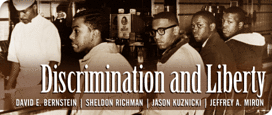Jason Kuznicki writes the following in support of Shelley v. Kraemer, in which the Supreme Court held that judicial enforcement of racially restrictive covenants was unconstitutional: “If we’re willing to accept that state action to enforce a contract remains state action all the same, then Shelley isn’t such a leap after all, and the supposedly “private” discrimination of the racial covenant was no such thing. It was a state-enforced discriminatory action, and thus clearly impermissible.”
I agree with Kuznicki that judicial enforcement of restrictive covenants constitutes “state action,” and is therefore subject to the restrictions of the Fourteenth Amendment. The problem, however, is that the Court failed to explain why this particular form of state action is a denial of “equal protection of the law,” which was the basis for holding it unconstitutional. The answer cannot be that enforcing a private party’s discriminatory preferences is unconstitutional. Even today, there is no doubt that if a white bigot called the police to throw a black person out of his house, and the police complied, this would be state action, but not a violation of equal protection of the laws. Moreover, no court is going to hold that the judiciary is engaging is unconstitutional state action when it enforces a wide range of other contracts and other legal documents that include discriminatory provisions, such as a provision in a will that disinherits an heir if he marries a Catholic.
One can argue, therefore, that Shelley is a perfect legal realist case: the Court wanted to favor civil rights, pure and simple, and it just made up a rationale that it refused to follow in other contexts. In fact, however, while hardly a model of clarity, the Court does provide two plausible, even persuasive, justifications for its ruling in Shelley.
First, the state action involved in Shelley was of a different magnitude than it would be in a normal action for enforcement of a contract. In Shelley, neither the buyer nor the seller wanted the property’s restrictive covenant enforced. Rather, it was a third party, a neighbor, who brought the force of the state in. Thus, the courts were being asked to enforce a discriminatory provision in a deed against the wishes of both the owner and purchaser of the subject property. This sort of scenario provides more room for “public policy” considerations to come into play than if a party to the transaction at issue was trying to enforce a relevant contractual provision.
Second, while state enforcement of racial covenants may seem racially neutral, the Court pointed out that it knew of “no case in which a court, state or federal, has been called upon to enforce a covenant excluding members of the white majority from ownership or occupancy of real property on grounds of race or color.” In other words, enforcement of restrictive covenants only operated in one direction, and that was to exclude African Americans from housing opportunities. The Court was too deferential to the state courts to say so, but state courts typically refused to enforce all sorts of other, more minor, restrictions on alienability of property. This suggests that enforcement of restrictive covenants may indeed have been not just state action, but discriminatory state action.
This argument receives further support from the fact that just about all states, including the ones involved in Shelley, had official or unofficial policies supporting residential segregation. It’s therefore difficult to see the states’ judiciaries’ actions as completely sui generis contract enforcement, as opposed to being part and parcel of an official or semi-official government policy favoring racial segregation and exclusion.
Unfortunately, the Court muddied these arguments at the end of its opinion, by suggesting that even if blacks and whites were equally excluded from housing opportunities by restrictive covenants, enforcing such covenants would still be unconstitutional, because “equal protection of the laws is not achieved through indiscriminate imposition of inequalities.”
However, we need not accept all of the Court’s reasoning to agree that the Court was correct to hold that in historical context, and given the background common law rule disfavoring restraints on alienation, enforcing restrictive covenants was unconstitutional. And we should also be able to agree that in other contexts, it’s perfectly constitutionally acceptable for courts to enforce contracts with provisions we find troubling, so long as courts do so even-handedly, enforcing a contractual provision favoring blacks over whites, or Muslims over Christians, or gays over straights, as quickly as the reverse.

